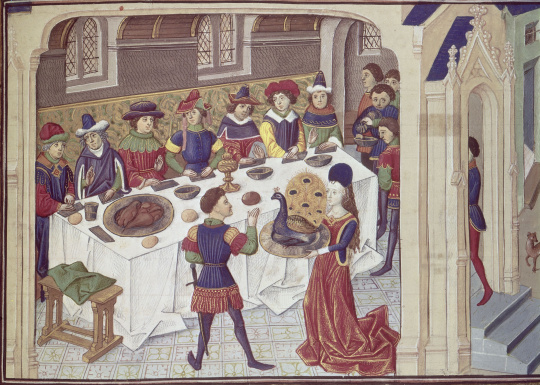Medieval meatrolls for the win! - Journeying through a medieval recipe
Medievals ate massive joints of meat straight off of the bone while wiping their faces on sleeves and tablecloth and tossing the bones on the floor - just like Hollywood History class has taught us, right?
Hate to disappoint but...no.
By contrast to this charming set of imagery, Medieval cuisine was immensely varied, complex and sophisticated, accompanied by a detailed set of rules of table etiquette, including which fingers to use with which types of food, rules for washing fingers before, between and after eating, and in some cases quasi-religious rituals of service intended to recall the Last Supper and other Church ceremonies.
Medieval dishes across Europe consisted of exotic flavor combinations and intense spices from the East, with sweet, sour and savory all combined. So let us explore one original medieval recipe and attempt to recreate it using my ill-equipped modern, yet dated kitchen!
The dish we are exploring today is called Allowes de Mutton. It hails from a collection of recipes ascribed to the Head Cook of King Richard the II, referred to in the oldest manuscript copy as a Forme of Cury.
Note that the medieval word “cury” has nothing to do with Indian “curry” – the medieval English word is a corruption of the Middle French “cuire”, to cook. In other words, “The manner of cooking”.
This recipe comes from the version found in Harleian Manuscript 4016, which is supposedly housed in the British Library, but I have been unable to find a record of it actually being there, or even a digital verison of the original manuscript. If you know where to find a digital record of this original, please let me know in the comments below!
Speaking of manuscripts, sidenote – especially for people in organizations that abuse the word “scroll” - the earlier version of a Forme of Cury is in fact a proper scroll, with leaves sewn together and stored as a roll! 
Now back to our source. The original recipe reads:
Take faire Mutton̄ of the Buttes, and kutte hit in þe maner of stekes; And þen̄ take faire rawe parcelly, and oynons shred smale, yolkes of eron̄ sodden̄ hard, and mary or suet; hewe all þes smale togidre, and then̄ caste thereto pouder of ginger, and saffron̄, and stere hem togidre with thi honde, and ley hem vppe-on̄ þe stekes al abrode; and cast there-to salt, and rolle hem togidre, and put hem on̄ a spitte, and roste hem till þei be ynogℏ.
Well, hopefully that has whett your appetite! If you are interested in the rest of the journey, check out this video!




